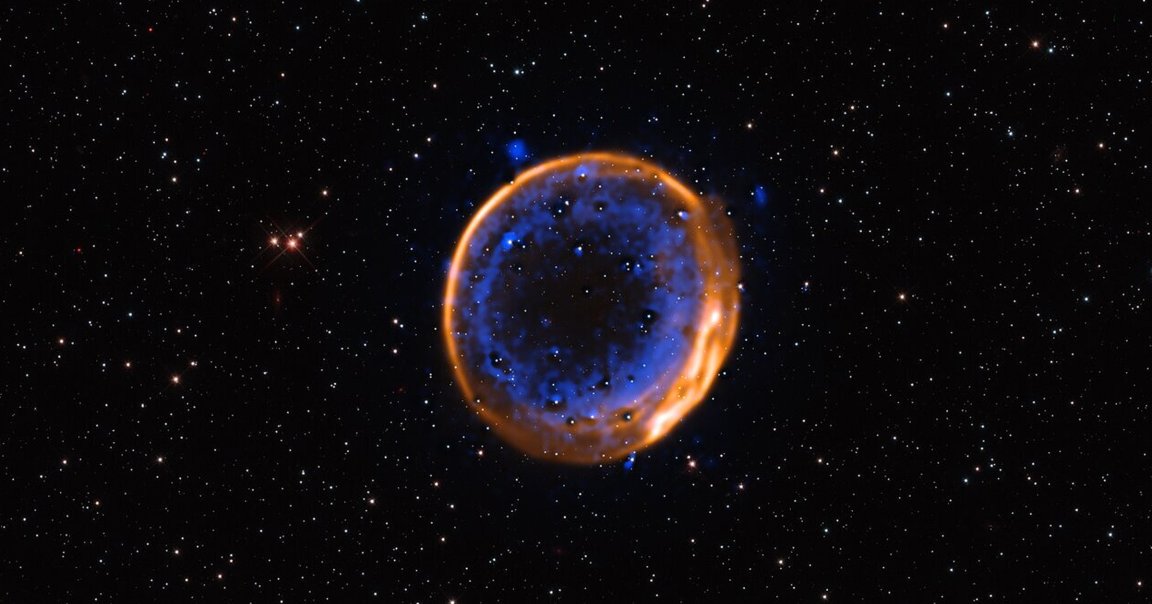
For years, scientists have suspected that stars can meet their doom by a one-two punch of back-to-back explosions — but they’ve never seen visual evidence of this happening.
That just changed. Astronomers using the Very Large Telescope in Chile have taken the first-ever image of a star that died in a stellar “double-detonation,” leaving behind a spectacular supernova remnant.
Their findings, published as a new study in the journal Nature Astronomy, deepen our understanding of the stellar evolution of burned-out stars called white dwarfs.
“The explosions of white dwarfs play a crucial role in astronomy,” lead author Priyam Das, a researcher at the University of New South Wales Canberra, Australia, said in a statement about the work. “Yet, despite their importance, the long-standing puzzle of the exact mechanism triggering their explosion remains unsolved.”
Once an exceptionally massive star — one at least several times heavier than the Sun — burns through all its fuel, it collapses under its own gravity in a powerful explosion known as a supernova.
That’s just one way supernovas can happen, though, and not all of them end the same. Some result in the star being completely obliterated, but others, if the star is heavy enough, can produce a super dense core called a neutron star, or even a black hole.
The scene imaged by the VLT is the work of what’s called a Type Ia supernova, produced by a low-mass star that exhausted all its fuel and left behind a remnant called a white dwarf. These objects are more compact and far denser than their original stars, endowing them with a wicked gravitational pull.
In binary systems, this powerful gravity can lead to the white dwarf stripping matter off its stellar companion if their orbits are close enough. When enough of this stolen material accumulates on the surface of the white dwarf, reaching a point known as critical mass, it kickstarts a single but incredibly destructive thermonuclear explosion that wipes out both stars.
That’s the typical understanding. More recent research, though, has found evidence that some white dwarfs are battered by two explosions, not one, prior to winking out. In this scenario, astronomers believe that a white dwarf is swimming in a cloud of siphoned helium. This unstable helium cloud is the first to explode, precipitating a second blast in the core of the star. And bam: you have a two-fer supernova.
Critically, this type of supernova occurs before the white dwarf reaches critical mass. Astronomers predicted that this double-detonation would produce a unique, visual signature in the form of two separate shells of calcium — and the new image bears this out. If you look closely, you can see that the calcium, depicted in blue, is indeed in a two-shell arrangement.
This is a “clear indication that white dwarfs can explode well before they reach the famous Chandrasekhar mass limit, and that the ‘double-detonation’ mechanism does indeed occur in nature,” said coauthor Ivo Seitenzahl, who conducted the observations while at the Heidelberg Institute for Theoretical Studies in Germany, in the statement.
The work is invaluable for another reason. Type Ia explosions are considered “standard candles” that astronomers use as a measuring stick in the cosmos, because they shine at a consistent luminosity. Now we understand a little more about why that’s the case.
“Revealing the inner workings of such a spectacular cosmic explosion is incredibly rewarding,” Das said.
More on stars: Scientists Working to Decode Signal From Earliest Years of Universe